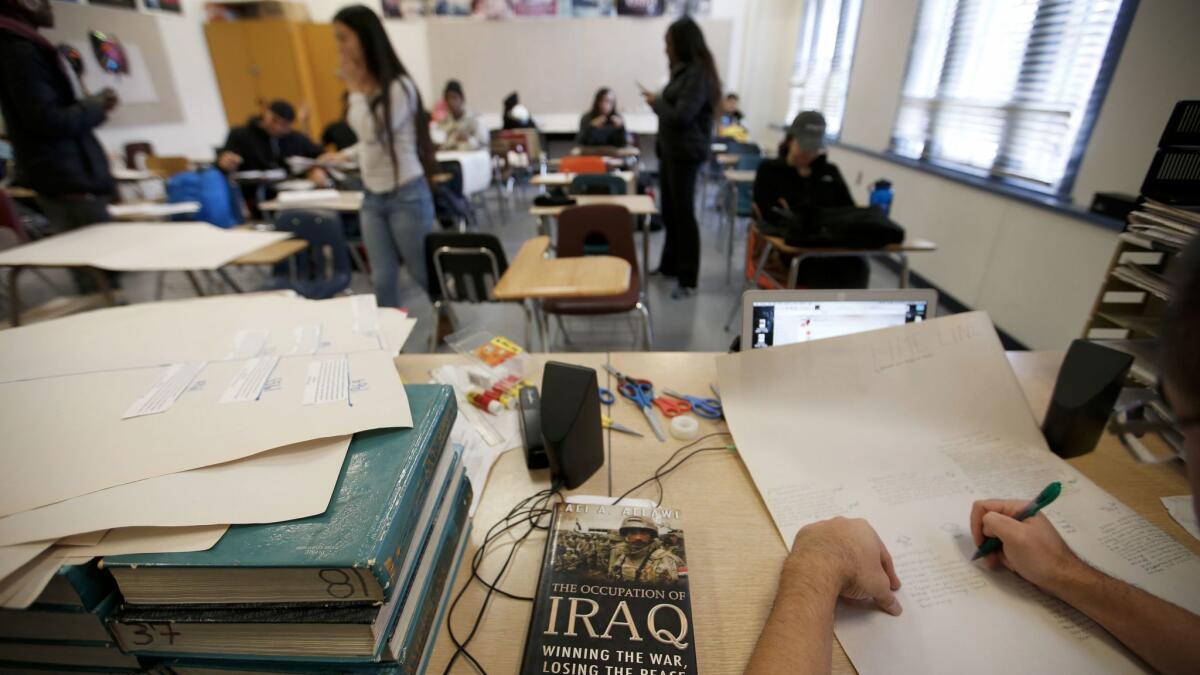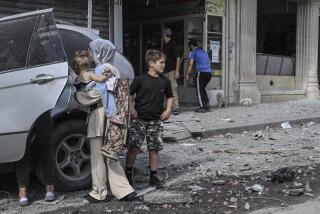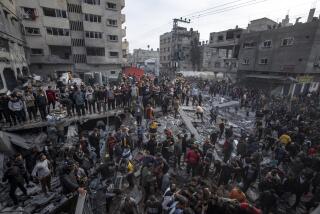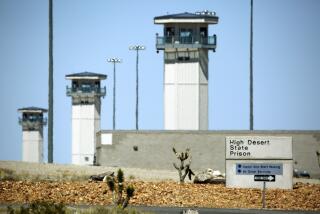Who’s tracking casualties in Iraq? A California high school teacher

Oakland social studies teacher Joel Wing started his “Musings on Iraq” blog eight years ago, but began tracking casualties in earnest earlier this year as forces geared up for the Oct. 17 Mosul offensive.
- Share via
Joel Wing, a high school social studies teacher in Oakland, was at home working on his MacBook Air one recent afternoon when he saw troubling news out of Baghdad.
The United Nations had just released its estimate for the number of soldiers and other fighters killed in Iraq in November: 1,959 security forces dead, a number that looked like the highest monthly total in two years.
For the record:
7:48 p.m. Aug. 22, 2019Jan. 21, 7:11 p.m.: An earlier version of this article incorrectly identified Bruno Geddo as the head of the U.S. refugee agency in Iraq. He represents the United Nations refugee agency.
But that wasn’t what was really troubling Wing. The U.N. also announced that it would be releasing no future combatant casualty estimates: Iraqi military commanders had been criticizing the reports, calling their numbers “inaccurate and much exaggerated,” and the international agency was bowing out until “a sound methodology of verification can be found to better substantiate the figures.”
“It was a sad moment for tracking the violence and security situation in Iraq,” said Wing, who immediately fired back on his nine-year-old blog, “Musings on Iraq.”
“The Iraqi Joint Operations Command said that those figures were exaggerated without giving any correction of its own,” Wing wrote, noting that the U.N.’s decision, “will create a huge gap in keeping up with the cost of the war.”
Someone would have to fill it. For many who have followed the war in Iraq and the number of lives it has claimed, that would be Wing.

The 47-year-old teacher at Oakland Technical High School has never been to Iraq, but he has become one of the go-to sources for reliable data and trends on the violent toll of the 14-year-old conflict in the troubled country.
Wing, a native of Berkeley who earned a bachelor’s and master’s in international relations at San Francisco State University, then a teaching credential at nearby Mills College, has been teaching English and social studies at Oakland Technical High School since 1995.
Back then, Wing’s main passion was music. He played bass in several punk, ska and heavy metal bands: Dance Hall Crashers, Corrupted Morals, Bumblescrump and Desecration. Rasputin Records in Berkeley put his photo in the window on Telegraph Avenue, and as the bands toured, he got to know members of big-league groups like Metallica and Green Day.
But when the U.S. invaded Iraq in 2003, Wing found himself deeply troubled and was determined to understand the country. He launched his blog as a way to reflect and connect with experts.

Four years ago, as he sensed a battle looming to confront the militant group Islamic State’s widening hold on territory, he began compiling and posting casualty figures. Soon, academics and experts around the world began following his work.
Wing is older now, with shorter, spiky black hair and glasses, but still has no particular political agenda and takes no outside funding for his blog. His twitter profile photo is of Raiden, the Japanese god of thunder and lightning recently popularized in the Mortal Kombat video game (and the 1986 cult classic “Big Trouble in Little China”).
Wing reads 44 English and Arabic language newspapers daily, with the help of Google Translate, and has always posted regular analysis, civilian and combatant casualty totals.
Since the offensive began to retake Mosul, he expanded his blog to include daily analysis of the attacks.
He has shared interviews with Iraq experts, including Bruno Geddo, head of the United Nations refugee agency in Iraq, the governor of Anbar province, former military commanders, CIA analysts and diplomats.
Wing compiles figures from attacks reported in the media as well as from U.N. figures. He includes locations, allowing him to report that 63% of attacks last year occurred in the provinces surrounding Baghdad and Mosul.
The totals represent a disturbing trend: The number of Iraqi combatants killed in November was 1,988, the highest monthly death toll since Islamic State seized Mosul in June 2014 — and more than all the Americans killed each year since the 2003 invasion.
(A total of 4,514 U.S. forces have been killed in Iraq, with the highest death toll occurring in 2007, when 904 Americans were killed, according to the icasualties website.)
Wing loves to network and talks to everyone, from contractors removing roadside bombs in Fallujah to Iraqi reporters in Baghdad, one of whom was killed in a bombing last year which was documented on his blog.
Michael Knights, an Iraq expert at the Washington Institute for Near East Policy, called Wing a “committed Iraqi analyst — very emblematic of how technology mixed with obsessive interest can nowadays create experts in unconventional ways.”
“His work is a solid collation of open source data and decent trend spotting from the data. It is a legitimate source. He spotted a lot of stuff before traditional analysts and even intel agencies,” Knights said.
Hamit Dardagan, who co-founded the London-based Iraq Body Count website in 2003, which tracks mainly civilian casualties, called Wing “amazing,” his numbers credible.
Dardagan said Iraqi government criticism of the release of casualty statistics appears politically motivated.
Combatant casualty figures are closely guarded by Iraqi military commanders, who see them as damaging to morale and a propaganda boost for Islamic State.
“They’re concerned about winning and anything that might weaken morale is something they’re going to be very careful with,” Dardagan said.

As Wing sees it, he’s providing a public service. “Violence is part of everyday Iraqi life. It’s important to keep track of what’s going on and how much the violence has cost the country in terms of people’s lives,” he said.
There’s a history of such laymen tracking Iraq casualties. After the 2003 invasion, a Bay Area anti-war activist and Georgia software engineer built the icasualties.org site into the most reliable source for accurate figures on U.S. casualties there and, later, in Afghanistan. But that website, like others of its kind, doesn’t track Iraqi combatants.
Wing has faced his share of scrutiny from Iraq experts.
“All of these people are in Washington, D.C., and they’re like, ‘Who is this Joel Wing guy? Why is he in California? A high school teacher?’,” Wing said as he sat in his classroom after school one recent afternoon, the wall covered with whiteboards and photos from dozens of former pupils.
He’s had a student serve in Afghanistan, but not in Iraq. His 12th grade American history students, whom he calls “my kids,” seem to take only a passing interest in his blog and the Iraq books on his desk (he’s reading Sir John Chilcot’s 12-volume report on the war, published in July).
Wing tries to limit blogging to his lunch, conference period and after school, but that doesn’t always work. His girlfriend has taken to calling his MacBook “your other girlfriend,” he said, “because I’m always on the computer doing Iraq stuff.”
The Pentagon has asked Wing to come work for them as an analyst, but he declined. He also declined two opportunities to travel to Iraq, once when the U.S. ambassador asked him to serve at the embassy for six months. He can’t leave his 140 students behind, he says.
“I’m very committed to teaching at a public urban school,” Wing said, “and wasn’t going to step away from the kids for that much time.”

Oakland social studies teacher Joel Wing started his “Musings on Iraq” blog eight years ago, but began tracking casualties in earnest earlier this year as forces geared up for the Oct. 17 Mosul offensive.
Twitter: @mollyhf
More to Read
Sign up for Essential California
The most important California stories and recommendations in your inbox every morning.
You may occasionally receive promotional content from the Los Angeles Times.











